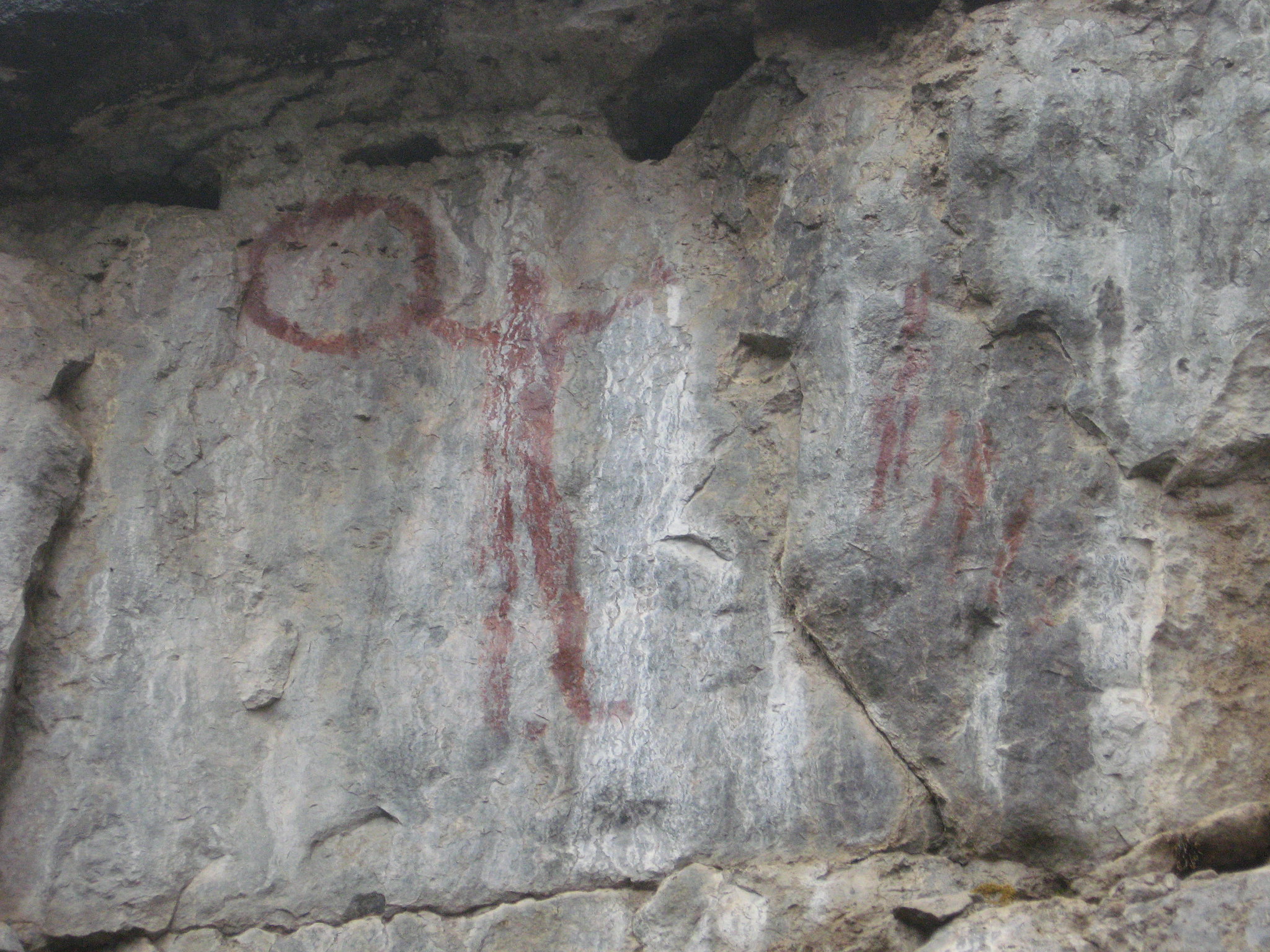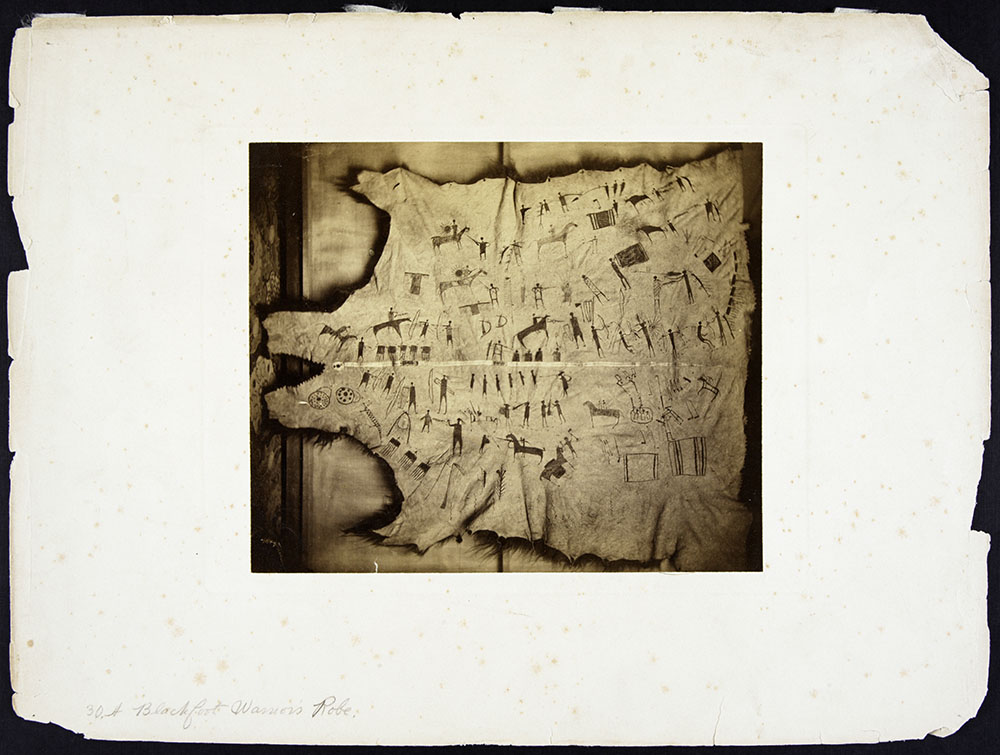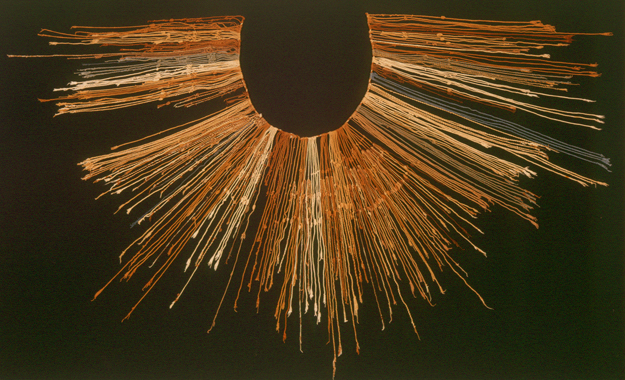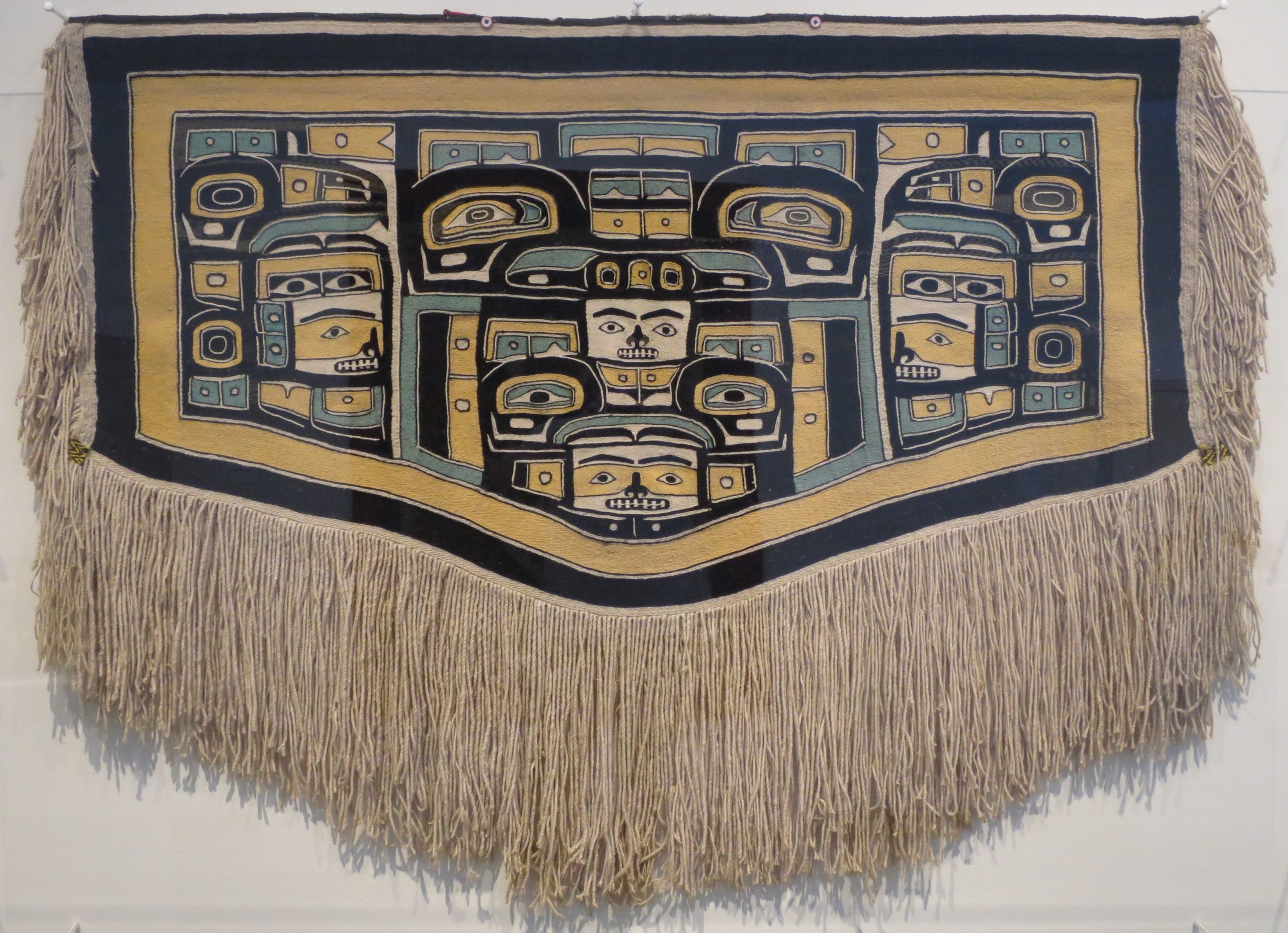2. Listen Up

The idea of “history” is not an unchanging one in any culture. Whether it is mythic, heroic, or civic, the story of the past serves a particular purpose and audience. As is the case with the oral traditions of many Indigenous nations, the oral tradition of the Hul’qumi’num-speaking peoples of the Coast Salish nations observe a difference between syuth (true histories) and sxwi’em’ (fables and moral tales).[1] The two are not necessarily at odds and may complement one another. In either form, one common function of histories across cultures is that they legitimate a society’s claim to be where it is. This is not the same thing as a claim to territorial sovereignty or ownership; it begins with a statement of belonging with and sometimes to the land. Histories, then, can be highly metaphorical, if metaphor serves the history’s purpose best.
For millennia, Indigenous history was maintained by many means. Some Indigenous societies in the Western Hemisphere produced written records for centuries before Europeans arrived.
The Written Record
Sébastien Rale, a Jesuit missionary in Wabanakiak (a.k.a.: Acadia) in the first two decades of the eighteenth century, observed figurative writing among his hosts:
While I was endeavoring to recover from my fatigue, one of the [Abenaki] who had camped on the Seashore, and who was ignorant of my return to the Village, caused a new alarm. Having come to my quarters, and not finding me, or any of those who had camped with me, he did not doubt that we had been carried away by a party of Englishmen; and, going on his way in order to inform the people of his own neighborhood, he came to the shore of a river. There he stripped the bark from a tree on which he drew with charcoal the English surrounding me, and one of the number cutting off my head. (This is the only writing of the [Natives], and they understand each other by figures of that kind as well as we understand each other by our letters.) He immediately put this sort of letter around a pole, which he set up on the shore of the river, so that passers-by might be informed of what had happened to me. A short time after, some [Natives] who were paddling by the place in six canoes, for the purpose of coming to the Village, perceived this sheet of bark: “Here is some writing,” said they, “let us see what it says. Alas!” exclaimed they on reading it, “the English have killed the people in our Father’s neighborhood; as for him, they have cut off his head.”[2]
As the Jesuit missionary observed among Wabanaki peoples, some Indigenous peoples maintained records in material forms. The practice of doing so extended well beyond the northeastern regions. Pictographs and petroglyphs are two well-known examples. Written/drawn documents include Nindoonem pictographs. Anishinaabeg signatories in the contact era deployed their Nindoonem as a kind of official seal with remarkable consistency across generations, although European observers regarded them as little more than illiterate sketches (sometimes used as signatures).[3] Wikhegan (mostly maps inscribed on birch bark) are another Anishinaabe document, as are images carved into the living wood of trees, which were commonplace in the Northeastern Woodlands and the Atlantic region. The “Midewiwin scrolls” associated with the Anishinaabeg medicine society of the same name are considerably more complex documents. Their subject matter ranged from maps (like the wikhegan) to spiritual tales and lessons. Niitsitapi (a.k.a. Blackfoot) and other Plains peoples inscribed their histories and personal accomplishments on their robes and the walls of their tipis. Not surprisingly, all of these are images whose information is dependent on an interpreter, and these skills became less and less common as alien diseases, warfare, and relocation interrupted the connection between the past and its heirs. And, of course, records made of birch bark are by their nature highly vulnerable. Many, too, disappeared into the hands of Christian missionaries and collectors where they met with any kind of fate, including willful destruction.

Most, however, relied on community memory rather than material records. Rigorous and highly disciplined memorization and ritual repetition stand at the centre of this process, as does community familiarity with a story. A succession event could, for example, call for the telling and retelling of family/community/clan histories. This takes place even now in many Indigenous communities where the preservation and presentation of histories remains a critical part of cultural and community resilience. What’s more, events like the potlatch—a ceremonial giving away of goods, usually associated with significant community events like a leader’s death or a marriage or an inheritance—had contractual elements that functioned like historic documents: by accepting goods at a potlatch, a guest/recipient took on the obligation to remember the event, to recall it, to validate it, to bear witness, and to pass on knowledge of the event to successors. (Nineteenth- and twentieth-century attempts by settler society to obliterate ceremonies like the potlatch and the Sun Dance thus threatened the very fabric of historical memory in Indigenous communities.)
It is for these reasons that oral tradition remains critical to the preservation of Indigenous histories. In Indigenous traditions, the ownership of a story—something that is handed down through generations—invests the account with its own importance and meaning. In Gitxsan territory, the hereditary houses own an adaawk—a collection of sacred oral tradition about their past and their lands; likewise, their neighbours the Wet’suwet’en refer to kungax—a dance or song in which their connection to the land is performed. Whether recounted as a story or danced or sung or performed in some other way, the history is regarded as consistent and reliable. Over time, some stories—especially if they migrate from traditional languages to a different language—might acquire more contemporary elements. A new language might require a new metaphor, for example, in order for it to make sense. The ability to relate the story well and truthfully, however, is paramount. European observers in the seventeenth and eighteenth centuries commented repeatedly on the oratorical skills of Indigenous speakers (and similar comments would be made on the West Coast, on the Plains, and in the far north in later centuries). What they were witnessing was the fruit of a venerable tradition of speaking and knowledge-sharing that adhered closely to the core elements of a story. On the whole, Indigenous audiences regard oral accounts of the past as valid and trustworthy.
What’s more, many Indigenous societies embraced—and continue to embrace—a circular or cyclical view of time rather than a linear view (the perspective espoused by European societies). Like the seasons and the rotations of the moon, time was generally regarded as a pattern of renewal. Ascendant young leaders inherited the position and the name of their predecessor in what was, theoretically, a renewal and not a replacement. The Aztec calendar effectively rebooted every 52 years. Euro-Canadians who look for Indigenous historical knowledge that runs parallel with the linear traditions of the Judeo-Christian world will mostly be frustrated. Myth, metaphor, and allegory loom large in Indigenous tales of the past, partly because “the past” is expressed differently in different cultures.
Privileging the written word, European and Euro-Canadian historians overwhelmingly disregarded and sometimes disparaged the oral tradition. This behaviour was typical of many Europeans in the Western Hemisphere. The Spanish were the most explicit and obvious in their hostility toward Indigenous historical records, destroying written and inscribed accounts throughout the Aztec Empire; in the Incan Empire they destroyed quipu—mnemonic assemblages of knotted strings that could have represented any number of record types—and prohibited their use and study. In New France, British North America, and Canada, the colonialist strategy was more subtle: it simply denied the existence of a historic past.


Take c̓əsnaʔəm, or the Marpole Midden, a traditional village and burial site of enormous importance to the Xwméthkwiyem (a.k.a. xʷməθkʷəy̓əm or Musqueam) First Nation in what is now the city of Vancouver. A roadbuilding crew exposed the site in the 1880s and a systematic academic archaeological dig got underway, one that lasted until the 1950s. The evidence pointed to occupation that stretched back at least fifteen hundred years and abandonment sometime in the mid-1700s. Even in the mid-twentieth century, commentators wondered who the occupants of c̓əsnaʔəm might have been, despite the fact that their descendants—the Xwméthkwiyem—made the provenance very clear. The Ottawa Citizen newspaper in 1948 took the view that, whoever they were, the people whose remains constitute the Marpole Midden “. . . were not Indians certainly.”[4] This tendency to deny a history before colonization survives in the practice among some scholars and commentators—still found in some quarters today—to refer to the period before the arrival of Europeans as “pre-historic.” The alleged absence of anything verifiable or reliable (essentially euphemisms for written documentation) allowed newcomers to write their own history over top of Indigenous histories.
What’s more, European and Euro-Canadian accounts of Indigenous societies proceeded from the perspective of newcomer needs, concerns, fears, ambitions, and values. An eighteenth-century fur trader from Montréal or the Orkney Islands is more likely to journal about beaver pelts than, say, Cree moral debates and Ktunaxa (a.k.a. Kutenai, Kootenay) understandings of the past. In short, there can be issues with sources and with perspective. Europeans in the early contact period might transcribe Indigenous voices, but that is always filtered through the Europeans’ lens of what is important and how they understood the speaker. While these records ought not to be discarded out of hand, they are nevertheless accounts which tell us as much about the reporter’s perspective(s) as they do of Indigenous experience.
Academic historians’ approaches to Indigenous pasts began to change in the 1970s. Non-Indigenous scholars, such as Bruce Trigger, broadened their historical approaches to include techniques borrowed from several other disciplines, particularly ethnography. Described as “ethno-history,” this emergent methodology included paying heed to oral traditions. Inevitably, stories lined up with other evidence, enabling Trigger to transform understandings of the pre-, proto-, and post-contact history of the Wendat (a.k.a. Huron). At first, Western scholars were astonished that Indigenous knowledge included centuries-old elements. One correlation followed on another. A Huu-ay-aht story of massive loss of life resulting from a catastrophic flood on the west coast of Vancouver Island around 1700 was treated by settler scholars as a kind of allegory until it was connected with a significant seismic event and consequent tsunami that occurred on 26 January 1700. Indeed, the Huu-ay-aht story helped confirm the timing, character, and magnitude of the event. Farther up the west coast, the Heiltsuk (a.k.a. Bella Bella) people’s history includes the insistence that their direct ancestors lived in their region for many millennia; recent archaeological evidence validates this claim back about fourteen thousand years. By the 1990s, Indigenous people were growing visibly impatient with the condescension of academia: they had never doubted the reliability of this historic knowledge.[5]
Naming Names
The issue of nomenclature looms large in the study of Indigenous societies in the past. You’ll find throughout this textbook that we have given precedence to names that may be unfamiliar. These are either the ancient, pre-colonial names of Indigenous communities and cultures, or they are the names currently preferred by Indigenous communities. To understand the importance of this issue, see the two-part Active History posting on this topic and the discussion by Chelsea Vowel. [6] There is, at the end of the book, a glossary of the names of Indigenous nations whose histories are surveyed or mentioned in the text.
In 1994, University of Victoria anthropologist and historian Wendy Wickwire published a landmark study of the Nlaka’pamux oral tradition.[7] In it, she compares Indigenous accounts—as told to a scribe nearly a hundred years earlier and as told to Wickwire herself in the late twentieth century—with the 200-year-old published accounts of North West Company trader Simon Fraser. The Nlaka’pamux stories meet Fraser on detail after detail, notwithstanding the fact that Fraser’s own accounts come off in this comparison as self-aggrandizing and rather economical with the truth.[8] This study appeared at a time when land claims were advancing in British Columbia and demands for treaty negotiations were growing. Scholars like Wickwire, Robin Fisher, Catherine Carlson, Arthur “Skip” Ray, Victor Lytwyn, and many others were routinely called to appear in court to provide “expert testimony,” while oral tradition was treated as unworthy of consideration. In 1997, Indigenous communities in Northern British Columbia made the challenge in court themselves. And they succeeded. In Delgamuukw v. Supreme Court of British Columbia, Chief Justice Lamer agreed that the courts have a responsibility to “come to terms with the oral histories of aboriginal societies, which, for many aboriginal nations, are the only record of their past.”[9] A series of cases involving claims by the Tsilhqot’in Nation, beginning in 2009 and continuing through 2014, reinforced and expanded the courts’ recognition of oral tradition.
In the twenty years since Delgamuukw, a number of trends have emerged in historical writing. More scholars have cultivated respectful relationships like those Wickwire nurtured with generous knowledge keepers in the Syilx (a.k.a. Okanagan) and the Nlaka’pamux First Nations. Increasingly, these have turned to life histories that remove the academic as the arbiter of information. The truth and complexity of memory and history become the principal message. This can be seen in Written as I Remember It: Teachings (Ɂəms tɑɁɑw) from the Life of a Sliammon Elder, in which the stories and teachings of Elsie Paul are presented in collaboration with UBC historian Paige Raibmon and Paul’s granddaughter, Harmony Johnson (an engaged Indigenous scholar in her own right).[10] Collaborations of this kind take not only an enormous amount of time, but a deep ethical commitment to community-based research. And yet, the principle of respectful partnerships of this kind is visibly gaining ground, not least because, in the wake of Canada’s recent Truth and Reconciliation Commission on Indian Residential Schools, post-secondary institutions are increasingly compelled to support it.
“Vindication” may seem like the right word here, but it has been more like an education.[11] Euro-Canadian society as a whole has been slow to grasp the strength and depth of Indigenous historical knowledge. Doing so, however, opens the door to a much richer understanding of the past. One historian, Bill Turkel, has written about “the archive of place,” referencing the record of landmarks, footpaths, trade routes, fishing holes, hunting meadows, meeting points—all of which speaks to a living and current knowledge. These archives, however, are not public libraries. The knowledge is not customarily in the public domain. Indigenous societies speak of knowledge keepers, not necessarily knowledge providers. Under no obligation to disclose their historical knowledge, Indigenous peoples nevertheless have the right to demand truthfulness in historical studies.
Resource
Thomas King is a storyteller who tells stories about storytelling. In 2003, he gave six Massey Lectures on the topic. Listen to as many as you like, but please be sure to listen to the first of them, in which he addresses creation stories.
King, Thomas. “The Truth about Stories: A Native Narrative.” CBC Massey Lectures, 2003. https://www.cbc.ca/radio/ideas/the-2003-cbc-massey-lectures-the-truth-about-stories-a-native-narrative-1.2946870
- Brian Thom, “Coast Salish Senses of Place: Dwelling, Meaning, Power, Property and Territory in the Coast Salish World,” (unpublished PhD dissertation, McGill University, 2005), 81. ↵
- Sébastien Rales. “Letter from Father Sébastien Rales, Missionary of the Society of Jesus in New France, to Monsieur his Brother.” In The Jesuit Relations and Allied Documents, vol. 67, ed. Reuben Gold Thwaites (Cleveland: The Imperial Press, 1900), 132–229. ↵
- See Heidi Bohaker, “Reading Anishinaabe Identities: Meaning and Metaphor in Nindoodem Pictographs,” Ethnohistory 57 no. 1 (2010): 11–33. ↵
- Susan Roy, “ ‘Who Were These Mysterious People?’: c̓əsnaʔəm, the Marpole Midden, and the Dispossession of Aboriginal Lands in British Columbia,” BC Studies 152 (Winter 2006/07): 67–95. ↵
- Pay a visit to Heiltsuk territory via their website: it highlights old village sites and food harvesting systems. Húyat, accessed October 4, 2019. ↵
- Brittany Luby, Kathryn Labelle, and Alison Norman. “(Re)naming and (De)colonizing the (I?)ndigenous People(s) of North America – Part I.” Active History, November 7, 2016. http://activehistory.ca/2016/11/renaming-and-decolonizing-the-indigenous-peoples-of-north-america-part-ii/; “(Re)naming and (De)colonizing the (I?)ndigenous People(s) of North America – Part II.” Active History, November 8, 2016. http://activehistory.ca/2016/11/renaming-and-decolonizing-the-indigenous-peoples-of-north-america-part-i/; Chelsea Vowel, “A Rose by Any Other Name Is a Mihkokwaniy.” âpihtawikosisân, January 16, 2012. http://apihtawikosisan.com/2012/01/a-rose-by-any-other-name-is-a-mihkokwaniy/. ↵
- Wendy Wickwire, "To See Ourselves as the Other’s Other: Nlaka’pamux Contact Narratives," Canadian Historical Review, 75 (1) (1994): 1-20. ↵
- Similar and more recent developments in this field include Robin Ridington, “Dane-zaa Oral History: Why It’s Not Hearsay,” BC Studies, 183 (Autumn 2014): 37-63 and Iain McKechnie, “Indigenous Oral History and Settlement Archaeology in Barkley Sound, Western Vancouver Island,” BC Studies, 187 (Autumn 2015): 193-229. While each new study reinforces the reliability and verifiability of oral tradition, none have appeared that offer a contrary view. ↵
- Delgamuukw v. British Columbia, [1997] 3 S.C.R. 1010, § 84. ↵
- A digitally remediated version of this book has been produced by Paul, Raibmon, and Johnson -- along with Paul's grandson, Davis McKenzie -- and is available through RavenSpace Publishing. ↵
- Note the appearance of the word in the title of this important article by Gitxaała knowledge-keeper and anthropologist, Charles Menzies, “Revisiting ‘DM Sibilhaa’nm da Laxyuubm Gitxaała (Picking Abalone in Gitxaała Territory)’: Vindication, Appropriation, and Archaeology,” BC Studies 187 (Autumn 2015): 129–53. ↵

